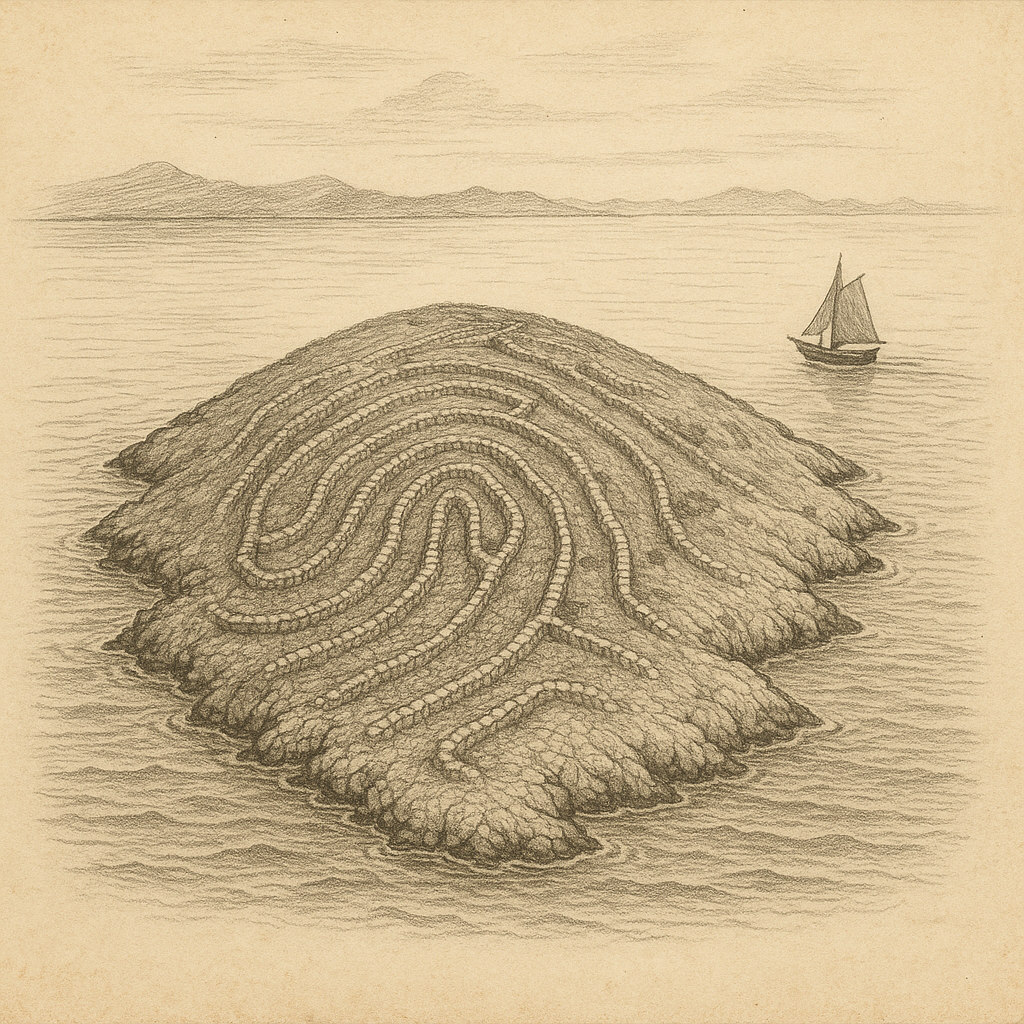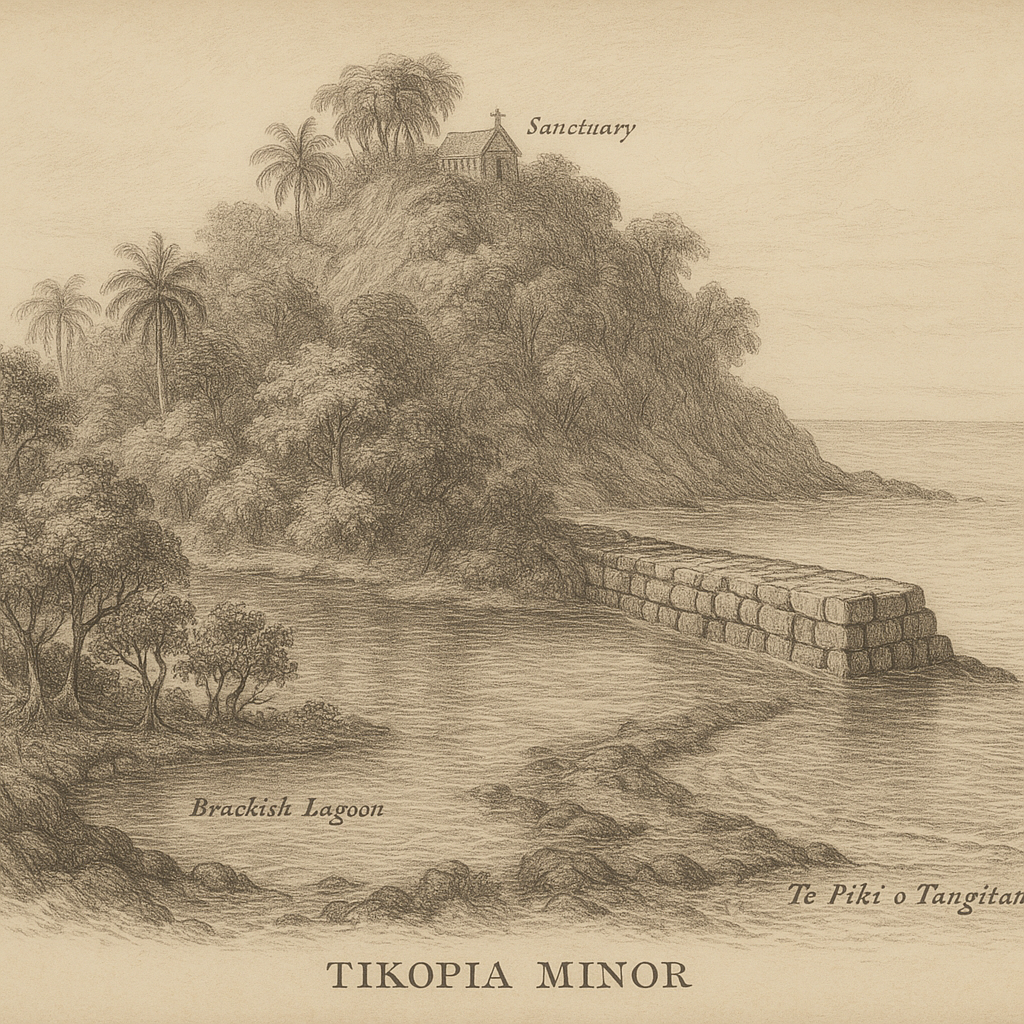Introduction
Baljenac Island, also known as Bavljenac, is a small yet captivating islet situated in the Adriatic Sea off the coast of Croatia. Located near the town of Šibenik in the Šibenik archipelago, this tiny island has gained international attention due to its unusual appearance—often likened to a fingerprint when viewed from above. With its intricate network of dry-stone walls, fascinating local legends, and untouched natural beauty, Baljenac Island is a unique destination that offers a glimpse into both history and mystery.
Geographical Location and Features
Baljenac Island lies just off the Dalmatian coast and forms part of the Šibenik archipelago in central Dalmatia. It is situated approximately 300 meters from the mainland and is easily visible from the popular tourist island of Kaprije. Baljenac spans only about 0.14 square kilometers in area and measures roughly 500 meters in length, yet despite its small size, it is densely crisscrossed with an extraordinary network of dry-stone walls.
These walls, constructed by human hands centuries ago, were used to demarcate plots of agricultural land. From an aerial perspective, these walls produce a labyrinthine pattern that resembles the ridges of a human fingerprint. This unique feature has earned Baljenac its nickname as the fingerprint island of Croatia.
Geological Origin
Baljenac Island, like many in the Adriatic Sea, was formed millions of years ago through tectonic activity along the eastern Adriatic coastline. The island is predominantly composed of limestone, a common geological feature in the region. Over centuries, natural forces such as erosion and weathering have shaped the island’s rugged terrain and contributed to its arid soil conditions.
This stony landscape presented significant challenges to early inhabitants or land users, who overcame them by employing the traditional method of dry-stone wall construction. These walls are built without the use of mortar, relying on precisely placed stones that lock together through gravity and friction. This technique not only helped create space for vineyards, olives, and other crops but also offered protection from strong coastal winds.
Climate and Ecology
The climate on Baljenac Island is Mediterranean, characterized by hot, dry summers and mild, wet winters. This climate is conducive to hardy plant species adapted to high salinity and limited moisture. The island supports a variety of drought-resistant shrubs, herbs, and grasses. Wildlife is limited due to the island’s small size and isolation, although seabirds are known to nest in the nooks provided by the rocky terrain and manmade walls.
Because there is no permanent human habitation on Baljenac today, its ecosystem has remained relatively undisturbed. However, the historical land use has left a visible imprint on the landscape, making the island a living record of traditional agricultural techniques and environmental adaptation.
Human Influence and Stone Wall Network
Perhaps the most striking feature of Baljenac Island is its network of dry-stone walls, totaling over 23 kilometers in length—an astonishing figure considering the island’s modest size. These walls were built by locals from the nearby island of Kaprije, who used Baljenac as agricultural land, particularly during the 19th century.
The purpose of these walls was to maximize arable space, protect crops from wind, and delineate ownership. Because machinery could not be used on the stony terrain, all construction was done by hand, stone by stone, over generations. These walls have remained remarkably intact due to the skilled craftsmanship of their builders and the stable climate.
In recent years, Croatian authorities have advocated for the inclusion of Baljenac’s stone wall system on UNESCO’s World Heritage list, aiming to recognize and preserve this unique cultural landscape. In tandem with this recognition, efforts are being made to document, map, and maintain the site using drones and digital technology.
Interesting Facts About Baljenac Island
– From an aerial view, Baljenac Island looks uncannily similar to a human fingerprint, a visual that has gone viral on social media and attracted curiosity from travelers and researchers worldwide.
– Despite being uninhabited, the island holds more than 23 kilometers of meticulously arranged dry-stone walls—more than many larger inhabited islands in Croatia.
– Baljenac is often studied in the context of traditional agricultural practices and considered an open-air museum of dry-stone walling techniques.
– Since the development of drone mapping technology, the entire network of walls has been cataloged and continues to be a subject of international interest in cultural preservation circles.
– The island is occasionally visited by boaters and tourists, especially those on excursions from nearby Kaprije, although access remains limited to preserve the fragile site.
Legends and Folklore
Like many places along the Dalmatian coast, Baljenac Island is steeped in local legends and folklore. One popular tale speaks of a sailor from Kaprije who, after shipwrecking near the island, survived by cultivating grapes and olives with sheer determination. According to the legend, he built the original stone walls himself as a testament to perseverance and the human spirit. It is said that on quiet summer nights, when the wind is just right, one can hear the echoes of his labor in the shifting stones—a ghostly memory of toil and hope.
Another legend tells of hidden treasure buried somewhere amid the island’s countless stone alleys. Passed down through generations, the myth suggests that a wealthy merchant, fearing an Ottoman raid, concealed his fortune within one of the wall enclosures. Treasure hunters have occasionally come to Baljenac, enticed by tales of gold and jewels beneath the limestone. None has found anything—yet the mystery persists, adding a touch of adventure to the island’s already intriguing allure.
Access and Conservation
Baljenac Island is uninhabited and has no facilities or infrastructure. Access is possible only by private boat or charter from nearby islands such as Kaprije or Žirje. Though visitation is not strictly controlled, conservation efforts have been intensified due to increased interest from tourists and media. Croatian heritage organizations are working to protect the ancient dry-stone walls, which are vulnerable to erosion and damage from careless foot traffic.
As part of Croatia’s broader efforts to preserve traditional dry-stone techniques, Baljenac is seen as a symbol of national identity and resilience. Visitors are encouraged to respect the site, refrain from disturbing the stone structures, and leave no trace behind.
Conclusion
Baljenac Island is a remarkable example of human ingenuity harmonizing with nature. Its labyrinth of stone walls tells stories of survival, heritage, and mystery. Although small and uninhabited, it offers a rich experience for those who appreciate culture, history, and natural beauty. As efforts to preserve and recognize the island continue, Baljenac stands as a humble yet powerful testament to the legacy of forgotten labor and timeless wonder.



